Gods take over London Olympics in stylistic 3D short
This action packed, low-poly 3D short sees the Gods of Olympus descend upon central London to battle it out in a trial of athleticism to light the Olympic torch.
This brilliant new short brings the Olympics back to London - only this time, it's the Gods of Olympus in a race to light the Olympic torch.
The stylistic, low-poly 3D film was created by creative agency Masters of Pie, the team of which specialise in character driven 3D apps, games and motion graphics. Here, we talk to Masters of Pie co-founder and director Karl Maddix about the short's production.
How did the brief for The Olympians come about?
"Masters Of Pie had just formed as a new startup and as Matt (Ratcliffe) and I are both artists at heart, we wanted to create something to showcase our combined talents - something with a strong visual style, that would make our new studio stand out.
We wanted to create something with a strong visual style, that would make our studio stand out
"I'd experimented with a low-poly style with some character work a few weeks before and so we decided to push that style as far as we could within the short time frame."
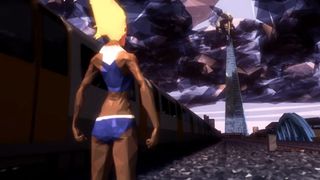
What were the film's influences, both story-wise and stylistically?
"For the story, I was reading a great space opera novel at the time called Ilium by Dan Simmons, which featured amazingly rich characters from Greek mythology, and as the Olympics were coming soon to London, combining the two themes seemed obvious to us.
"As we researched around the low-poly style, we came across Constructivism and The Vorticists, in particular the illustrations by Zaha Hadid. These fractured shapes were so dynamic and full of energy that we fell in love with them. We used those as our yard stick for modelling everything you see in the short, both character and architectural."
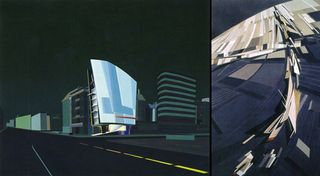
How long did the animation take to produce?
"It was done in two chunks, the first was a three-month crunch period trying to create key scenes from our storyboard that we could put together as a kind of trailer for the film we knew we didn't have time to produce. We got some brilliant client work in around that time which demanded our full attention and so we left The Olympians as a simple art test piece.
Around 6 months production, but the last two were about rendering and polishing in Cinema 4D
"The second chunk of work came a few months ago once we had some down time in-between projects that coincided with the Anniversary Games in London. The Olympics were back in the news and so we dedicated another three-month period to completing the film and putting it out there. In total it was around six months' production, although the last two in honesty were about rendering and polishing in Cinema 4D."
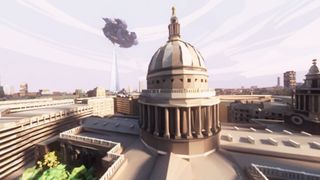
What 3D software did you use and why?
"The characters were modelled up as high res sculpts in ZBrush and then retopped before exporting to 3ds Max. In Max, I would hack away at them and use Optimiser modifiers until they were suitably fractured. The topology was terrible mind you and even though I tried to add back in edge loops around deforming joints, they were basically a riggers worst nightmare! Nevertheless, our friend Liam Lambert did an amazing job getting them rigged for animation, without shouting at me too much.
The characters were basically a riggers worst nightmare!
"The characters and cameras were set up and animated in 3ds Max and exported as FBX files. The environment was a big job, we wanted as many recognisable landmarks modelled up along our route as possible and so we enlisted another couple of friends to help us model them.
"This meant that Maya, Modo and Max were all involved at some point before we exported everything into Cinema 4D ready for rendering. C4D was great at handling the insane poly counts involved in the scenes and was also used to smash stuff up and make water, clouds, lightning, etc. V-Ray for Cinema 4D was used for lighting and rendering before the whole thing was composited together in After Effects."
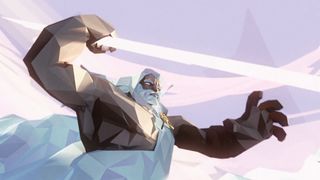
What was the most technically impressive aspect of the project and how was it achieved using 3D software?
"Matt and I each have our favourite pieces. As a character artist, I love Cerberus. How Liam managed to create a useful rig for that crazy guy I will never know. But combined with the Cinema 4D low-poly smoke, I think Cerberus stands out as a lovely bit of graphics.
"Matt would likely argue that the lighting was the most impressive technical aspect, which he did mostly using V-Ray. The low-poly style in particular really benefits from great lighting in our opinion, as facets pick up lights and reflections in a haphazard way, this really boosts the energy you can get, especially with action packed scenes like ours."
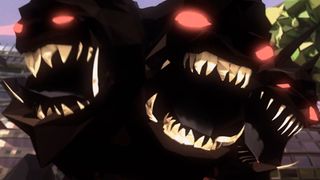
Did you make any mistakes during production?
"Plenty! Most of which were to do with exporting pivot points correctly. We had a bit of a torrid time with those to be honest, especially trying to get animated target cameras out of Max and into Cinema.
"In the end we were baking camera animation to teapots and then exporting those instead, using them to recreate the camera motion in C4D. I am sure there must be better ways that we didn't know about to do that properly!"
Did you use or develop any new or notable techniques?
"Maybe, we aren't sure. Because we were under time pressures we basically made it up as we went along, meaning we didn't have time to research the best way to achieve a 'look' so we just used brute force methods to get it done.
"I doubt many people would chose to model characters in the way I did for this, due to mangled topology etc, but I knew that to get an organic fractured look to them, I couldn't have organised edge loops, etc. I threw quads out of the window and just trusted the rigger to find a way, which he did. Perhaps the aforementioned teapot method was unique!"
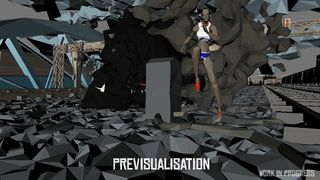
What are you working on now?
At Masters of Pie, we like to work on a broad range of projects and so continue our work on apps and games, as well as using new technology like the Oculus Rift to tell stories and give experiences.
"There's an idea for a quirky children's animation that I am playing around with currently but it's too early to tell if it will see the light of day any time soon. In a nutshell, we like to work with characters and narrative using new and interesting tech. Like everyone, we patiently wait for our Hoverboards to be invented."

Liked this? Read these!
- Top free 3D models
- Hands-on review: 3ds Max 2014
- Blender tutorials: ways to create cool effects
Have you seen any inspirational 3D shorts recently? Let us know in the comments!

Thank you for reading 5 articles this month* Join now for unlimited access
Enjoy your first month for just £1 / $1 / €1
*Read 5 free articles per month without a subscription

Join now for unlimited access
Try first month for just £1 / $1 / €1
Get the Creative Bloq Newsletter
Daily design news, reviews, how-tos and more, as picked by the editors.
The Creative Bloq team is made up of a group of design fans, and has changed and evolved since Creative Bloq began back in 2012. The current website team consists of eight full-time members of staff: Editor Georgia Coggan, Deputy Editor Rosie Hilder, Ecommerce Editor Beren Neale, Senior News Editor Daniel Piper, Editor, Digital Art and 3D Ian Dean, Tech Reviews Editor Erlingur Einarsson and Ecommerce Writer Beth Nicholls and Staff Writer Natalie Fear, as well as a roster of freelancers from around the world. The 3D World and ImagineFX magazine teams also pitch in, ensuring that content from 3D World and ImagineFX is represented on Creative Bloq.
